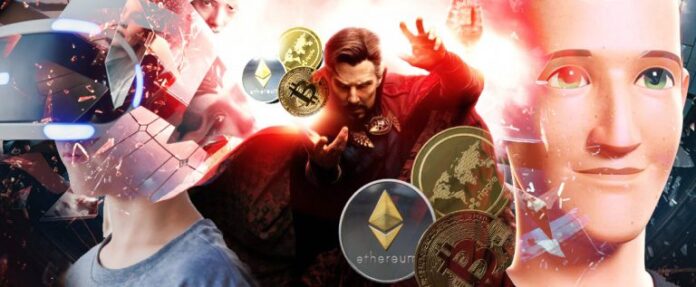
“The real meaning of Web3 is all about community”, says DayAway’s Waslen
There are few conversations that don’t feel surreal in 2022, yet since the carnage in the crypto-currency market, businesses built around blockchain have had a particularly rough ride. Yet as WiT 2022 said ‘Hello Other World’ to these brave new players, Luke Clark discovers that beneath the hype, seeds of travel’s next evolution remain.
“It is very strange to be back here,” Marissa Trew told the audience from her panel moderator seat at WiT Singapore 2022. She could easily have been referring to the otherworldly feeling many at WiT had of simply being in a different country again, after so many years working out of our spare rooms.
Yet given that she lives in Singapore, Trew’s feeling of dislocation was more vocational. The last time she’d been onstage, it was as part of the WiT crew – now she was representing Web3-centred Blokhaus Inc.
Strange new realms do seem an oddly fitting note for a panel titled “Hello, Other World”, especially given the blockchain industry’s post-Armageddon feel right now – and the somewhat disconcerting notion that one of its favourite futuristic realms doesn’t yet exist. Strange times indeed.
Then again, attitudes can change within a year. A year ago, for instance, such a panel would have seemed very ‘now’ and far less otherworldly. Then from May 2022 of course, the bottom fellow out of virtual currencies, as the likes of The New York Times scanned the wreckage, announcing ‘Cryptocurrencies Melt Down in a ‘Perfect Storm’ of Fear and Panic’. Indeed, following its highs of April 2021, the king of crypto, Bitcoin, has lost 60% of its value since January 2022, with some predicting it may fall further.
Freeze frame to October 2022, and celebrity influencer Kim Kardashian has been issued a US$1.2 million fine just for advertising EthereumMax on her Instagram page. Suddenly, these unregulated virtual currencies seem so toxic that commentators like Gary Gensler of the U.S. Securities and Exchange Commission noted: “When it comes to crypto, remember many of these are highly speculative assets. You may be wondering if it’s right for you, or even if it might be a scam.”
Behind the hype – “blockchain can solve frictions around personalisation, flexibility in loyalty programming and membership”
In fairness, those who got on the virtual bandwagon were not doing anything new. As followers of business, we place huge importance on a tenuous notion – our current feelings about the future. This ranges from the importance of business confidence as a gauge of market potential, to the belief in so-called ‘unicorn’ businesses which, despite sometimes meagre earnings, are touted due to the market’s excitement at their potential.
The fact is, neither favour nor fear is logical when it comes to the future. Perhaps in time, we should become comfortable with the notion that with some things, we simply don’t know yet. Likewise, maybe we should also try to avoid glorifying, then demonising, technology breakthroughs: and just assess them more on their merits.
Indeed, it was this sort of line that the Hello, Other World panel would ultimately tread. “I think currently with market conditions in the crypto sphere being less than ideal, the natural scepticism continues to arrive,” says Trew. “Education is a key component, because it is basically trying to distil the opportunity from the hype – and if there’s anything we’ve seen in the last few years is that there is a lot of hype.”
Addressing what she calls the market’s “necessary scepticism” around Non-Fungible Tokens, or NFTs, is of course a key task for those building any genuine non-hype driven business around the blockchain.
This has certainly been the case for Martha Waslen, CEO and founder of DayAway. “I come from a Web3 background prior to getting into hospitality,” she explains. “When we launched our DayAway platform, core to our company was focusing on the customer experience – personalisation for them, and for us learning more about their needs and frustrations in the industry.
“When we were learning that they wanted experience above all else, personalisation and flexibility in loyalty programming and membership, it became really clear that blockchain could solve a lot of these frictions within the industry,” she says.

DayAway is starting with a blockchain-enabled loyalty program that Waslen describes as cross-vertical. It currently features primarily experiences in five-star luxury hotels. “But our guests were telling us they’re just as inclined to want to book experiences with private yacht companies, f&b experiences and luxury retail.”
By expanding its experiential inventory and building a blockchain-enabled loyalty programme, Waslen believes DayAway offers customers “tonnes of transparency and flexibility in how they redeem those points, and actually, converting those points into a digital asset with real monetary value.”
To Waslen, understanding this potential real-world benefit to better engage guests and improve the customer experience, represents a good way to appreciate the non-hyped potential of Web3. “At the most basic level, Web3 kind of defines all of these new technologies that are built on blockchain. That includes everything from cryptocurrencies, NFTs and the metaverse,” she says.
“But to me the real meaning around Web3 – and I think a lot of the Web3 network would say this – is it’s all about community.”
Solving a real-world challenge was the key to realising the ‘in-real-life’ potential of these new technologies, she underlined. “We knew that our community desperately wanted a new kind of loyalty programme, especially in the wake of Covid, where people weren’t travelling the way they used to, they weren’t staying at the same hotels,” she recalls.
“They wanted experiences, whether they were at home or abroad. And they wanted a loyalty programme that was kind of transitioning them across a number of different lifestyle verticals, in being able to redeem points, benefits, upgrades, and invitations to special events in a more frictionless way.”
DayAway has launched a first instalment of the Genesis NFT collection, called The Founders Key. A collection of 500 limited edition NFT’s, it is being sold currently to the company’s early adopters, investors and Web3 partners.
“It has been really interesting, because the reception from our work to the community has been overwhelmingly positive,” she says. For many customers, the loyalty programme would be the very-first NFT they had ever purchased. Those in the Web3 community had been thrilled about the DayAway project, she said, for its ability to show a sceptical market a “real-life utility, a real-world use case – an application for blockchain that the mainstream can understand”.
Many in the market may understandably struggle to understand why a collection of NFTs called CryptoPunks could be currently trading for billions of dollars. “That’s fine,” Waslen notes. “But a lot of people do care about their loyalty status,” she says.
“You start showing them that their points now have real monetary value on an open marketplace – this might be the bridge that brings hundreds more people into Web3 from some of the loyalty programmes of the biggest hospitality giants in the world. And I think in Web3, that’s our ultimate goal – mainstream adoption.”
Metaverse moment will arrive when interactive layer becomes as important as our physical lives – “it’s not here yet”
Real-world applications are not however, a term that can be placed with the metaverse – no matter how many virtual headsets that the company-formerly-known-as Facebook, is selling. “The metaverse is not people sitting there in virtual reality (VR) goggles – despite how many earnings calls from Mark Zuckerberg’s Meta you’ve seen,” notes Tom Simpson, Strategic Advisor for digital agency Anzu.io.
“The metaverse is really an interactive layer sitting across reality,” Simpson explains. “That interactive layer already exists – people spend most of their time on their smartphones. But it becomes more pervasive as augmented reality (AR) and VR technologies become a more standard part of the consumer experience.”
As such, a real metaverse will exist only once that layer really and truly matters to us all. “It probably describes the moment when that interactive layer becomes as important as our physical lives,” says Simpson. And as he and others like him underline, such a moment isn’t here yet.
As Harry McCracken in the October 2022 issue Fast Company points out: “The metaverse doesn’t exist yet. Sure, we’ve got virtual worlds such as Fortnite – and Roblox, Minecraft, Decentraland, and many others. But they aren’t the metaverse.”
The writer continues: “What the metaverse’s true believers are imagining is a universal, global 3D environment that seamlessly merges digital and physical realities – possibly via lightweight goggles you wear throughout your waking hours. That might still be many years away, if it comes to be at all.”
Simpson agrees that for adults at least, we’re not there yet. “If you’re talking about using the metaverse for marketing, then I mean just really kind of simplifying it – right now, the metaverse doesn’t really exist.”
Which of course has not stopped brands like Coke, Zara, Ferrari (through a digital 296 GTB supercar) or Nike (through a theme park called Nikeland) building things within the metaverse, or a host of venture capitalists and start-ups getting hyped about it.
Yet to really view the potential of what might one day exist, you either need to watch metaverse-driven movies like Ready Player One or Free Guy. Or just step into the world of the average nine-year-old. “There’s not a lot of people spending time in metaverses, but there’s a lot of people spending time in gaming. So gaming is really the metaverse,” Simpson explains. “And the metaverse kind of emerges from this gaming world.”

“Look at Gen Z behaviour, what they’re doing spending time within Fortnite,” he describes. “You’ve got a digital economy running with its own monetary system, V-bucks, and everybody’s spending all their money on ‘skins’. So for instance, how can they dress up to the pool – how can they have the coolest weapon? And that’s how they represent their identities. That’s how they represent their value to the world. And that’s just kind of built-in.”
In Web3, advertising will not be as significant, but customer relationships via NFTs and blockchain will be
Those who know nine-year-olds well also know that yesterday’s metaverse can be next year’s “meh”. Yet having originally come from an advertising background, Simpson says the promise for brands goes beyond sponsoring banners inside the likes of Minecraft.
Currently, the Web2 world is most easily understood for brands as an advertising space, where they ‘catch’ a lot of potential audience through placements in search- or social-driven sites. “In Web3, we kind of shift to a world where advertising isn’t as significant in terms of funding the world,” Simpson explains. “And one of the reasons for that is that consumers actually have control over their own data.”
Increasingly, Web3 consumers will be able monetise and control their data, using defi, or decentralised finance, to do so. “That data becomes much more consumer-controlled. So you have to have a relationship with consumers via NFTs and the blockchain.”
Currently, both panelists agreed that the hype around Web3, blockchain and NFTs has created too much hot air. “A lot of Web3 and the metaverse is a solution in search of a problem,” Simpson observes. “As ever, it just goes back to the basic business disciplines – establishing what the problem is, and whether any of the solutions out there help you deliver extra value against that.”
Waslen says that the Web3 world is best demonstrated within an all-inclusive environment such as a theme park, cruise or casino resort. “A really great example of this, long before mainstream awareness of Web3, was Disney creating that wearable token when you were at Disney World that opened your doors, purchased retail items, and allowed your kids to buy F&B,” she notes. “That’s not so different than using an NFT through a gated platform to buy things, book rooms, book travel.”
In hospitality, the Web3 world can potentially grant customers the benefit of extending your immersive experience after you’ve left your resort-based bliss. “Post-stay, you can still have this amazing community and this space – where you’re engaging with this community beyond just standing in the hotel,” Waslen explains. “So this is a much more immersive way for hospitality and travel brands to engage with their larger community.”

In many cases, the front line of the movement of Web3 will be moving away from the stigmatising building blocks that lie behind it, towards just focusing on its very real customer benefits. “In the next five-to-10 years, so many people are going to be interacting with NFT’s without even realising it,” says Waslen.
Simpson agrees that the future of Web3 will be driven by brands enriching the customer experience. “Technology works when it disappears into the background,” he says. “Consumers certainly don’t understand what blockchains are. They’re interested in what they do.”
Follow us:
Website: https://jeritexeu.com
Telegram: https://t.me/jeritex
Telegram: https://t.me/jeritexgroup
Twitter: https://twitter.com/jeritex
Facebook: https://www.facebook.com/Jeritex/






































